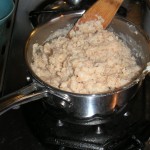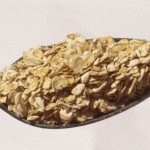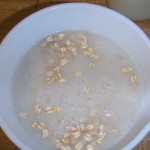by Cat, Feb 2007; updated Aug 2007 (photos by Cat unless indicated otherwise)
Topics and recipes in this article:
- Introduction
- On Rolling your own oats & other groats, Pre-soaking, and Sprouting
- Recipes:
- Regular Porridge (quick or long-cooking methods)
- Presoaked Porridge
- Sprouted-Grain Porridge
- Roasted-Grain Porridge
Grains, nuts and seeds all benefit from sprouting, or at least an overnight soak in an acidic medium (yogurt, whey, lemon juice added to water). Not all groats, nuts or seeds will sprout, but still increase in healthfulness and nutrition from an overnight soak.
See also: 1. How to Soak, Sprout and Ferment Seeds (Menu); 2. List of Articles on Grains, Nuts and Seeds (Menu); 3. Breakfast & Brunch Menu; 4. Granola & Meusli (General Instructions); 5. Granola & Meusli Recipes;
Introduction
What is a groat? It is the grain with the outer hull removed. The bran and germ are still intact. When using true grains (oat, barley, wheat, rye, kamut, spelt, etc.) and also buckwheat, you want the groat (dehulled or naturally hulless), as the grain with hull intact is much harder to sprout, and then you have to deal with removing the hulls before you cook the groats.
NOTE: Some groats, e.g. oats and barley, will not sprout because the germ is damaged/removed when the hull is removed (because the hull is difficult to remove). But there are varieties of oats and barley that are grown without a hull, and will sprout. These are called “hull-less.” Other grains like wheat and spelt easily shed their hull without damaging the germ, and will sprout. See Sprouting Grains for Porridge: The Hull Issue for more.
If your groats, nuts or seeds won’t sprout, I still recommend an overnight soak in acidic medium (adding yogurt, whey or lemon juice), which accomplishes much of what sprouting accomplishes at the biochemical level, you just don’t get the sprout tail.
See Sprouting Grains for sprouting instructions. Cooking instructions (and other recipes) based on Real Oatmeal (squidoo.com) (5)
Roasting: You can dry-roast in a cast iron skillet over medium heat (on stove-top) for 3 – 5 minutes (depending on grain type). See Stove Top Roasting for more.
Or lightly oil a baking sheet and roast them in a 325ºF oven for 10 – 15 minutes. See Oven Roasting (scroll down on page) for more
Why roast the groats, nuts, seeds? Roasting brings out the nutty flavor, much as toasting bread. However, the heat involved in roasting may have a detrimental effect on the oils and proteins, so I’m still not sold on roasting.
Recipes
See also see Granola and Meusli (About), Granola Recipes, and Muesli Recipes.
Plain Rolled/Flaked Grain Porridge (Hot Cereal)
You can make a great breakfast cereal from rolled grain. You’ll get the best, freshest product if you roll/flake/grind your own groats right before using. To maximize the nutritional value of the porridge, I recommend either pre-soaking the rolled/flaked grain overnight, or long-cooking it for 1 hour or more. Alternately, you can sprout the grain before cooking (don’t roll/flake the groat before sprouting).
Roll your own Oats and other Groats
(photo, left from Wikimedia Commons)
Rolled groats quickly lose nutritional content due to oxidation, so freshly rolled is best. 1 cup oat groats make about 2 cups rolled oats using a hand-operated or electric grain roller/flaker mill. (per Azure Standard (6))
I have a Family Grain Mill & Roller/Flaker Mill that can be hand operated, or attached to my Kitchen-Aid stand mixer (with an adapter). See Grains: Grinding (for flour) & Flaking/Rolling (for porridge) for more detail. See Pleasant Hill Grain – Oat Flaker Mill (8) for more on the mill.
Pre-soaking the rolled/flaked groats
I prefer to pre-soak the rolled grain overnight, before cooking to maximize the absorbable nutrients. You can use any cereal grain (oats, wheat, spelt, barley, kamut, etc.); see recipe, below.
While it takes 2 to 12 hours (overnight is good) for maximum benefit from soaking, the longer it is soaked, the more the cooking time is reduced. Set your porridge to soak before going to bed, then in the morning, it will cook in just a few minutes–just enough to make it hot.
Note on using oats if pre-soaking or long-cooking: Adding ground wheat berries provides additional phytase enzyme to assist the release of minerals in rolled or steel-cut oats, because oats are rather short on phytase.
Sprouting the groats
Sprouting the whole dehulled or hull-less groat (not rolled, flaked, or ground grain) over a couple days, before cooking, is the best preparation method, as it:
- Greatly reduces the amount of toxic lectins (like gluten) and phytates in the grain.
- Starts with a whole groat that is less likely to be rancid (think free radicals) from exposure of the fragile oils in the grain to oxygen, than rolled or flaked groats
- Does not need the addition of wheat to oats, for needed phytase enzyme.
See recipe, below. You can add chopped fresh or dried fruit to the soaked grains just before cooking, if desired. Or soak some nuts with your grains.
Regular Porridge Recipes
If you don’t wish to presoak your grain, you can have porridge in about 10 minutes. Or you can cook it very slow for an hour or so to improve the nutritional quality. See also Roasted Grain Porridge (not pre-soaked) in the last section, below.
Ingredients & Equipment:
- 1 cup freshly rolled grain*
- ½ tsp Unrefined sea salt*
- Fresh, filtered water to cover
- Equipment
- heavy bottomed saucepan (for the long-cooked recipe, you can use a slow-cooker instead, if you wish)
- wooden spoon or spatula
‘* Alternate ingredient amounts by serving size (I make the 2-serving size):
- For 1-serving: ⅓ cup roasted grain and ⅛ – ¼ tsp Unrefined sea salt
- For 2 servings: ⅔ cup roasted grain and ¼ – ½ tsp Unrefined sea salt
- For 4-servings: 1 ⅓ cup roasted grain and ½ – 1 tsp Unrefined sea salt
Quick-cooked method
NOTE: this is not made with the quick-cooking Quaker Oats, but rather with freshly rolled oats (or other grain). It is not as healthful as long-cooked.
- Place grain in heavy-bottomed saucepan with½ tsp Unrefined sea salt. Add fresh water to cover.
- Bring water to boil, then reduce to a low and continue at a slow boil for 5 – 10 minutes, stirring occasionally, until the oats have reached your desired level of creaminess, adding more water as needed.
Long-cooked (slow-cooked) method
- Place grain in heavy-bottomed saucepan or slow-cooker with½ tsp Unrefined sea salt. Add fresh water to cover.
- Bring water to boil, then reduce heat to lowest setting, using a simmer plate if necessary (or you can use a slow-cooker), so that the grain just steams.
- Cover pot and let cook for 1 hour or more, stirring every once in a while and check on water level.
- Add more water as necessary. Total water will be 2 – 4 times the volume of the oats. So if you started with 1 cup rolled oats, you’ll need 2 – 4 cups water.
- The longer you cook the porridge, the more nutritious it gets, as the lectins and phytates begin to break down.
Alternate long-cooked method
This uses 1 cup basic measure for about 3 servings; you can use less or more basic measure, and adjust amount of water proportionately.
- Place 1 cup (basic measure) in a bowl with 1 cup filtered water and let soak for 15 minutes or up to several hours.
- Then bring 2 cups of water to a boil in heavy-bottomed saucepan.
- Add soaked mixture and ½ tsp Unrefined sea salt.
- Return to a boil then turn heat to lowest setting; add a simmer plate.
- Cover the pot and cook for at least 45 minutes, adding water as necessary.
Pre-soaked and Sprouted Grain Recipes
See also Roasted Grain recipes (presoaked or not) in the next section, below.
Presoaked Porridge Recipe
You can make this porridge with a single grain type (such as oats), or sprout/soak a grain mixture (4-grain, 9-grain, etc.); for using roasted grains such as Montana Cream of the West’s 7-Grain (my favorite (9)), see Roasted Grain Porridge Recipe, below. If using oats, consider adding a few ground wheat berries to them, to improve deactivation of phytates, as oats don’t have as much phytase enzyme.
The following recipe, from the Rebuilding From Depression (10) website serves 3 – 4. Note that although the original recipe is for oats, you can use this same method for other grains or mix of grains.
An alternate method is to combine oats and ground wheat berries with only 1 cup of the water for the soak. Next day, add salt to remaining 1/2 cup water and warm in saucepan. Add soaked oats, stir and cook 2 – 5 minutes. (From Nourishing Traditions, by Sally Fallon)
Ingredients & Equipment:
- 1 cup old fashioned rolled organic oats
- 2 tsp fresh ground wheat berries
- 1 1/2 cups warm filtered water (113-1300 F)
- 2 Tbsp whey, yogurt, kefir or buttermilk (lemon juice or vinegar can be used if you have an allergy to dairy)
- 1/2 teaspoon Unrefined sea salt
- spice grinder or coffee mill
- medium bowl
Method:
- Soaking Grain Mixture (The night before): Grind wheat berries coarsely; mix with oats in bowl. Add whey to the warm filtered water in a measuring cup, stir to combine and then stir into oat mixture.
- Cover bowl with a cloth and let sit in a warm place overnight (7 – 24 hours).
- Cooking (In the morning): Transfer soaked mixture to a saucepan; add salt and place over medium-low heat, to warm 2 – 5 minutes until all the liquid has been absorbed and the porridge is warm. Add more water if necessary
Serving Suggestions:
- Serve with a dab of butter or cream-rich milk, and a bit of maple syrup or honey if you like a bit of sweetener.
- I’ve recently discovered cream and applesauce make a good topping.
- Sprinkle serving with 1-2 teaspoons nutritional yeast, and 1-3 teaspoons fresh-ground flax seeds (optional).
- Top with whole milk yogurt, preferably made at home from raw milk, and fresh berries or other fruit as desired.
- If adding nuts, it’s best to soak them with the oats overnight.
Sprouted Porridge Recipe
This requires groats that will sprout. If using oats or barley, you must use hull-less variety (grown without a hull), as de-hulled oats will not sprout. Wheat, spelt and kamut groats will sprout, as their hulls are easily removed without damaging the germ.
Groats will at least double in size when cooked. This recipe serves 3 – 4
Ingredients & Equipment:
- 2 cups organic oat (or other grain) groats, sprouted
- water to cover, or more for creamier porridge
- 1/2 teaspoon Unrefined sea salt
- 2 – 3 quart saucepan
Method:
- Sprout your groats over 2 – 3 days. Give them a final rinse and transfer them to a saucepan.
- Add pure water to cover; for creamier porridge add additional 1/4 – 1/2 cup water.
- Bring to a boil, then simmer about 15 minutes. Then let rest for 1/2 – 1 hour, to soak up more water.
- Reheat before eating. I like to put a serving in a small custard cup, then place it in my steamer to warm. I can fit 3 custard cups at a time in my steamer.
Roasted Grain Porridge Recipes
Here in Montana, there is a local company that makes great roasted grain for hot cereal: Cream of the West (9). I like their Roasted Seven-Grain variety. You can also use bulgur, which is sprouted or roasted then cracked wheat.
Sally Fallon (Nourishing Traditions) advises against roasted grains, asserting that the heat treatment oxidizes the sensitive poly-unsaturated oils in the grain, and does other nutritional damage, so for years I avoided roasted grains. However, I tested strong for the roasted oats and seven-grain products as well as roasted bulgur during food sensitivity testing, so I have come to believe that the heat damage might not be as great as Ms Fallon asserts. Perhaps the natural vitamin E in the whole grain seed provides adequate protection for the oils.
You can cook it without presoaking (presumably, roasting accomplished some of the same benefits as soaking), but I prefer the presoak to hedge my bets, and because it makes a creamier porridge. I provide both versions below.
Roasted Grain Porridge (without Pre-soak)
This recipe is adapted from a package of Montana Cream of the West Roasted Oats (9). Note: this recipe does not use salt.
Ingredients & Equipment
- For 1-serving: ⅔ cup water and ⅓ cup roasted grain
- For 2 servings: 1 ⅓ cup water and ⅔ cup roasted grain
- For 4-servings: 2 ⅔ cup water and 1 ⅓ cup roasted grain
- Equipment:
- saucepan
- wooden spoon for stirring
Method
- Bring water to a brisk boil;
- Gradually stir roasted grain into the boiling water.
- Cook at simmer for 5 minutes, stirring occasionally.
- Serving options:
- with sugar, honey, or maple syrup;
- with blueberries, pecans and lots of cream (my favorite)
Roasted Grain Porridge (with Pre-soak)
The rule of thumb is to use twice as much water as cereal. You can also add a bit of unrefined sea salt if you wish, or perhaps a light sprinkle of cinnamon.
You can also make your own roasted grain, but if you’re going to go to that trouble, then you might as well sprout it first, then simply toast it in your oven at a low setting to dry it out after sprouting. Then you can crack it if you wish (pound in a mortar or grind lightly using a coffee grinder or grain mill). Of course, to sprout the grain you want it without the hull (dehulled wheat or spelt; hull-less oat or barley).
For more on roasting grain, see LiveStrong.com: How to Roast Grain (11).
Serves 4.
Ingredients & Equipment:
- 1 ⅓ cups roasted grain cereal
- water to cover, or more for creamier porridge
- 2 ⅔ cups filtered water, warmed (110° F)
- 1 Tbsp yogurt or whey
- ¼ teaspoon Unrefined sea salt (optional)
- Equipment:
- 2 – 3 quart saucepan
Method:
- Measure cereal into bowl; add warmed water and yogurt/whey, and stir to combine. Cover with waxed paper and let soak overnight.
- Transfer to saucepan; bring just to a boil, then lower to a simmer and cook 5 minutes or more, to taste, stirring occasionally.
- Serve with warmed milk or cream. Add honey or fruits as desired – I like our local blueberries.
- Serving options:
- with warmed milk or cream
- sweeten with sugar, honey or maple syrup
- garnish with blueberries (or other berries), pecans (or other nuts) and lots of cream (my favorite)
References
- thatsmyhome.com/bakers/almond-crunch-granola/
- healthyshopping.com/stores/cart.asp?ItemNumber=STV-X-60 (link no longer valid)
- Nourishing Traditions by Sally Fallon with Mary G. Enig Ph.D.
- home-n-stead.com/homestead/tipsandrecipes/raw_breakfast.html
- squidoo.com/specialgarden (link no longer valid)
- azurestandard.blogspot.com/2011/03/have-you-ever-wondered.html
- homesteady.com/how-5585365-use-kitchenaid-attachments.html
- pleasanthillgrain.com/grain_flaker.aspx
- Montana Cream of the West
- rebuild-from-depression.com/simplechange/simplechange/simplechange/porridges.html (link no longer valid)
- How to Roast Grains: livestrong.com/article/435721-how-to-roast-grains/



